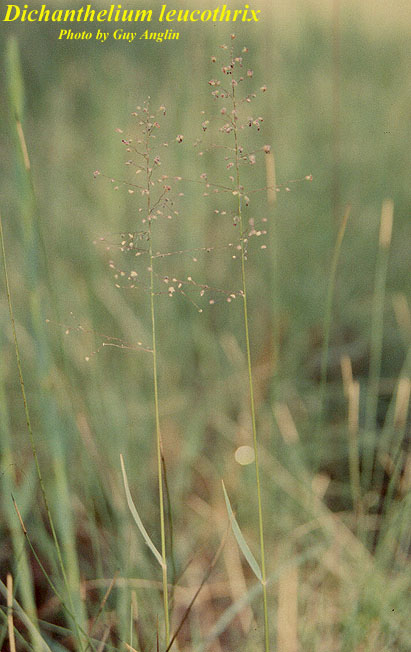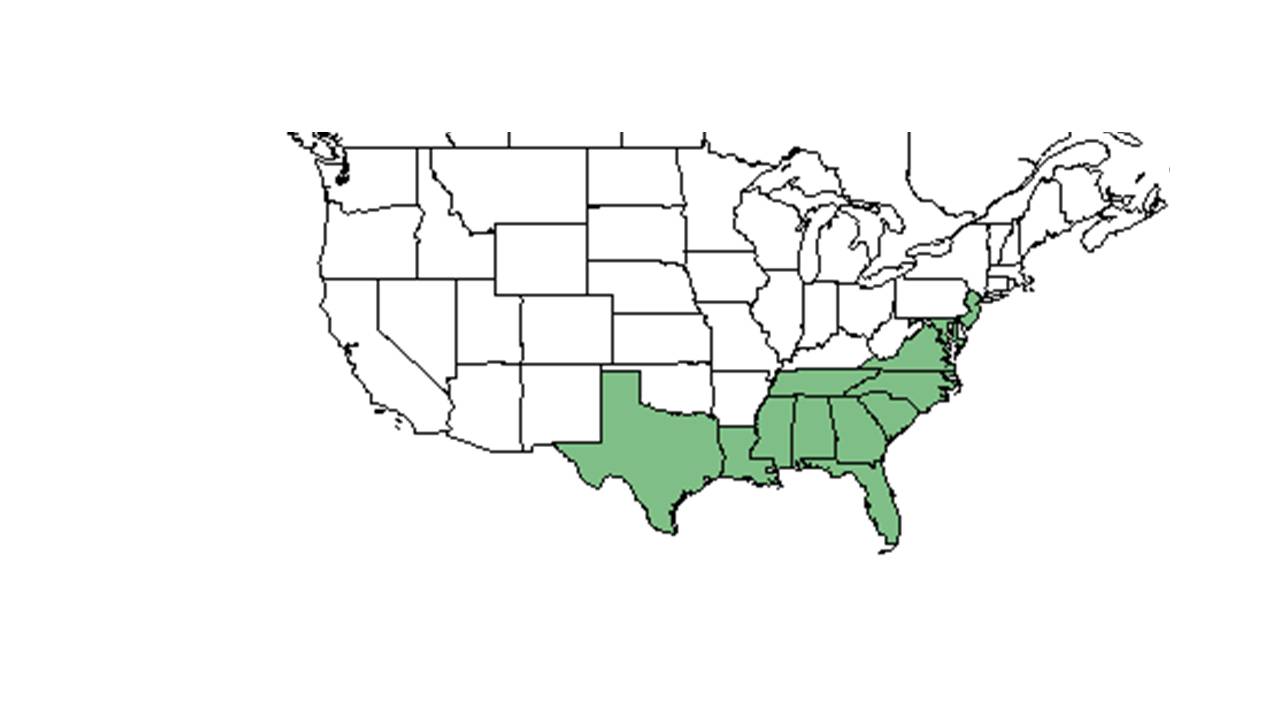Difference between revisions of "Dichanthelium leucothrix"
(→Photo Gallery) |
(→Taxonomic notes) |
||
| (13 intermediate revisions by 9 users not shown) | |||
| Line 8: | Line 8: | ||
| divisio = Magnoliophyta - Flowering plants | | divisio = Magnoliophyta - Flowering plants | ||
| classis = Liliopsida – Monocotyledons | | classis = Liliopsida – Monocotyledons | ||
| − | | ordo = | + | | ordo = Poales |
| familia = Poaceae ⁄ Gramineae | | familia = Poaceae ⁄ Gramineae | ||
| genus = ''Dichanthelium'' | | genus = ''Dichanthelium'' | ||
| Line 18: | Line 18: | ||
}} | }} | ||
| − | Common | + | Common names: rough panicgrass, rough witchgrass, roughish witchgrass |
==Taxonomic notes== | ==Taxonomic notes== | ||
| + | Synonyms: ''Dichanthelium acuminatum ssp. leucothrix'' (Nash) Freckmann & Lelong; ''Panicum acuminatum'' Swartz ''var. leucothrix'' (Nash) Lelong; ''P. leucothrix'' Nash; ''P. spretum var. leucothrix'' (Nash) D.B. Ward<ref name=weakley>Weakley, A.S. 2020. Flora of the Southeastern United States. Edition of 20 October 2020. University of North Carolina at Chapel Hill, Chapel Hill, North Carolina.</ref> | ||
| + | |||
| + | Varieties: none.<ref name=weakley/> | ||
| + | |||
==Description== | ==Description== | ||
<!-- Basic life history facts such as annual/perrenial, monoecious/dioecious, root morphology, seed type, etc. --> | <!-- Basic life history facts such as annual/perrenial, monoecious/dioecious, root morphology, seed type, etc. --> | ||
| − | Generally, for the ''Dichanthelium'' genus, they have "spikelets usually in panicles, round or nearly so in cross section, 2-flowered, terminal fertile, basal sterile, neutral or staminate. First glume usually present, 2nd glume and sterile lemma similar; fertile lemma and palea indurate without hyaline margins. Taxonomically our most difficult and least understood genus of grasses, more than 100 species an varieties are ascribed to the Carolinas by some authors. Note general descriptions for species groups (e.g., 1-4, 5-8, 9-13, and 26-62)." | + | Generally, for the ''Dichanthelium'' genus, they have "spikelets usually in panicles, round or nearly so in cross section, 2-flowered, terminal fertile, basal sterile, neutral or staminate. First glume usually present, 2nd glume and sterile lemma similar; fertile lemma and palea indurate without hyaline margins. Taxonomically our most difficult and least understood genus of grasses, more than 100 species an varieties are ascribed to the Carolinas by some authors. Note general descriptions for species groups (e.g., 1-4, 5-8, 9-13, and 26-62)." <ref name="Radford et al 1964">Radford, Albert E., Harry E. Ahles, and C. Ritchie Bell. Manual of the Vascular Flora of the Carolinas. 1964, 1968. The University of North Carolina Press. 142-155. Print.</ref> |
| − | Specifically, for the ''D. leucothrix'' species, they are "perennial with distinct basal rosettes; branching, when present, from nodes above basal rosette. Leaves basal and cauline, vernal and autumnal. Culms 3-6.5 dm tall, nodes slightly bearded, internodes glabrous or pilose. Blades to 6 cm long, 2-5 cm wide, glabrous above, setose basally, puberulent beneath, margins scaberulous, basally ciliate; sheaths sparsely pilose or glabrous, margins occasionally ciliate; ligules ciliate, 2-3 mm long. Panicle 3-6 cm long, 2.5-4 cm broad; rachis appressed pilose or glabrous, branches spreading, smoothish. Spikelets ellipsoid, 1.2-1.4 mm long; pedicels smoothish. First glume glabrous or pubescent, truncate or acute, 0.2-0.5 mm long, 2nd glume and sterile lemma pubescent, obtuse, 1.2-1.4 mm long; fertile lemma and palea 1.1-1.5 mm long. Grain not seen." | + | Specifically, for the ''D. leucothrix'' species, they are "perennial with distinct basal rosettes; branching, when present, from nodes above basal rosette. Leaves basal and cauline, vernal and autumnal. Culms 3-6.5 dm tall, nodes slightly bearded, internodes glabrous or pilose. Blades to 6 cm long, 2-5 cm wide, glabrous above, setose basally, puberulent beneath, margins scaberulous, basally ciliate; sheaths sparsely pilose or glabrous, margins occasionally ciliate; ligules ciliate, 2-3 mm long. Panicle 3-6 cm long, 2.5-4 cm broad; rachis appressed pilose or glabrous, branches spreading, smoothish. Spikelets ellipsoid, 1.2-1.4 mm long; pedicels smoothish. First glume glabrous or pubescent, truncate or acute, 0.2-0.5 mm long, 2nd glume and sterile lemma pubescent, obtuse, 1.2-1.4 mm long; fertile lemma and palea 1.1-1.5 mm long. Grain not seen." <ref name="Radford et al 1964"/> |
==Distribution== | ==Distribution== | ||
==Ecology== | ==Ecology== | ||
===Habitat=== <!--Natural communities, human disturbed habitats, topography, hydrology, soils, light, fire regime requirements for removal of competition, etc.--> | ===Habitat=== <!--Natural communities, human disturbed habitats, topography, hydrology, soils, light, fire regime requirements for removal of competition, etc.--> | ||
| − | ''Dichanthelium leucothrix'' can occur in longleaf pine-wiregrass flatwoods, and cypress-gum depressions in flatwoods | + | ''Dichanthelium leucothrix'' can occur in longleaf pine-wiregrass flatwoods, and cypress-gum depressions in flatwoods. <ref name="FSU Herbarium">Florida State University Robert K. Godfrey Herbarium database. URL: [http://herbarium.bio.fsu.edu http://herbarium.bio.fsu.edu]. Last accessed: October 2015. Collectors: H.L. Blomquist and Robert K. Godfrey. States and Counties: Florida: Liberty. North Carolina: Carteret.</ref> |
| + | |||
| + | ''Dichanthelium leucothrix'' is an indicator species for the Lower Panhandle Savannas community type as described in Carr et al. (2010).<ref>Carr, S.C., K.M. Robertson, and R.K. Peet. 2010. A vegetation classification of fire-dependent pinelands of Florida. Castanea 75:153-189.</ref> | ||
| + | |||
| + | <!--===Phenology===--> <!--Timing off flowering, fruiting, seed dispersal, and environmental triggers. Cite PanFlora website if appropriate: http://www.gilnelson.com/PanFlora/ --> | ||
| + | <!--===Seed dispersal===--> | ||
| + | <!--===Seed bank and germination===--> | ||
| − | |||
| − | |||
| − | |||
===Fire ecology=== <!--Fire tolerance, fire dependence, adaptive fire responses--> | ===Fire ecology=== <!--Fire tolerance, fire dependence, adaptive fire responses--> | ||
| − | ===Pollination=== | + | Populations of ''Dichanthelium leucothrix'' have been known to persist through repeated annual burns.<ref>Robertson, K.M. Unpublished data collected from Pebble Hill Fire Plots, Pebble Hill Plantation, Thomasville, Georgia.</ref> |
| − | === | + | <!--===Pollination===--> |
| − | ===Diseases and parasites=== | + | <!--===Herbivory and toxicology===--> |
| − | ==Conservation and | + | <!--===Diseases and parasites===--> |
| − | == | + | |
| + | ==Conservation, cultivation, and restoration== | ||
| + | |||
| + | ==Cultural use== | ||
==Photo Gallery== | ==Photo Gallery== | ||
<gallery widths=180px> | <gallery widths=180px> | ||
| Line 45: | Line 55: | ||
==References and notes== | ==References and notes== | ||
| − | |||
| − | |||
| − | |||
Latest revision as of 15:29, 24 May 2023
| Dichanthelium leucothrix | |
|---|---|

| |
| Photo by Guy Anglin, Atlas of Florida Vascular Plants | |
| Scientific classification | |
| Kingdom: | Plantae |
| Division: | Magnoliophyta - Flowering plants |
| Class: | Liliopsida – Monocotyledons |
| Order: | Poales |
| Family: | Poaceae ⁄ Gramineae |
| Genus: | Dichanthelium |
| Species: | D. leucothrix |
| Binomial name | |
| Dichanthelium leucothrix (Nash) Freckmann | |

| |
| Natural range of Dichanthelium leucothrix from USDA NRCS Plants Database. | |
Common names: rough panicgrass, rough witchgrass, roughish witchgrass
Contents
Taxonomic notes
Synonyms: Dichanthelium acuminatum ssp. leucothrix (Nash) Freckmann & Lelong; Panicum acuminatum Swartz var. leucothrix (Nash) Lelong; P. leucothrix Nash; P. spretum var. leucothrix (Nash) D.B. Ward[1]
Varieties: none.[1]
Description
Generally, for the Dichanthelium genus, they have "spikelets usually in panicles, round or nearly so in cross section, 2-flowered, terminal fertile, basal sterile, neutral or staminate. First glume usually present, 2nd glume and sterile lemma similar; fertile lemma and palea indurate without hyaline margins. Taxonomically our most difficult and least understood genus of grasses, more than 100 species an varieties are ascribed to the Carolinas by some authors. Note general descriptions for species groups (e.g., 1-4, 5-8, 9-13, and 26-62)." [2]
Specifically, for the D. leucothrix species, they are "perennial with distinct basal rosettes; branching, when present, from nodes above basal rosette. Leaves basal and cauline, vernal and autumnal. Culms 3-6.5 dm tall, nodes slightly bearded, internodes glabrous or pilose. Blades to 6 cm long, 2-5 cm wide, glabrous above, setose basally, puberulent beneath, margins scaberulous, basally ciliate; sheaths sparsely pilose or glabrous, margins occasionally ciliate; ligules ciliate, 2-3 mm long. Panicle 3-6 cm long, 2.5-4 cm broad; rachis appressed pilose or glabrous, branches spreading, smoothish. Spikelets ellipsoid, 1.2-1.4 mm long; pedicels smoothish. First glume glabrous or pubescent, truncate or acute, 0.2-0.5 mm long, 2nd glume and sterile lemma pubescent, obtuse, 1.2-1.4 mm long; fertile lemma and palea 1.1-1.5 mm long. Grain not seen." [2]
Distribution
Ecology
Habitat
Dichanthelium leucothrix can occur in longleaf pine-wiregrass flatwoods, and cypress-gum depressions in flatwoods. [3]
Dichanthelium leucothrix is an indicator species for the Lower Panhandle Savannas community type as described in Carr et al. (2010).[4]
Fire ecology
Populations of Dichanthelium leucothrix have been known to persist through repeated annual burns.[5]
Conservation, cultivation, and restoration
Cultural use
Photo Gallery
References and notes
- ↑ 1.0 1.1 Weakley, A.S. 2020. Flora of the Southeastern United States. Edition of 20 October 2020. University of North Carolina at Chapel Hill, Chapel Hill, North Carolina.
- ↑ 2.0 2.1 Radford, Albert E., Harry E. Ahles, and C. Ritchie Bell. Manual of the Vascular Flora of the Carolinas. 1964, 1968. The University of North Carolina Press. 142-155. Print.
- ↑ Florida State University Robert K. Godfrey Herbarium database. URL: http://herbarium.bio.fsu.edu. Last accessed: October 2015. Collectors: H.L. Blomquist and Robert K. Godfrey. States and Counties: Florida: Liberty. North Carolina: Carteret.
- ↑ Carr, S.C., K.M. Robertson, and R.K. Peet. 2010. A vegetation classification of fire-dependent pinelands of Florida. Castanea 75:153-189.
- ↑ Robertson, K.M. Unpublished data collected from Pebble Hill Fire Plots, Pebble Hill Plantation, Thomasville, Georgia.